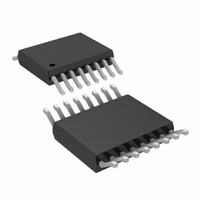LT3574IMS#PBF Linear Technology, LT3574IMS#PBF Datasheet - Page 15

LT3574IMS#PBF
Manufacturer Part Number
LT3574IMS#PBF
Description
IC PWM FLYBCK ISO CM 16MSOP
Manufacturer
Linear Technology
Type
Flyback, Isolated, PWM - Current Moder
Datasheet
1.LT3574EMSPBF.pdf
(24 pages)
Specifications of LT3574IMS#PBF
Internal Switch(s)
Yes
Synchronous Rectifier
No
Number Of Outputs
1
Voltage - Output
Adj to 60V
Current - Output
650mA
Frequency - Switching
40kHz ~ 1MHz
Voltage - Input
3 ~ 40 V
Operating Temperature
-40°C ~ 125°C
Mounting Type
*
Package / Case
16-MSOP
Voltage - Supply
3 V ~ 40 V
Frequency-max
1MHz
Duty Cycle
52%
Pwm Type
Current Mode
Buck
No
Boost
No
Flyback
Yes
Inverting
No
Doubler
No
Divider
No
Cuk
No
Isolated
Yes
Lead Free Status / RoHS Status
Lead free / RoHS Compliant
Available stocks
Company
Part Number
Manufacturer
Quantity
Price
applications inForMation
Overdriving the BIAS Pin with a Third Winding
The LT3574 provides excellent output voltage regulation
without the need for an opto-coupler, or third winding, but
for some applications with higher input voltages (>20V),
it may be desirable to add an additional winding (often
called a third winding) to improve the system efficiency.
For proper operation of the LT3574, if a winding is used as
a supply for the BIAS pin, ensure that the BIAS pin voltage
is at least 3.15V and always less than the input voltage.
For a typical 24V
will improve the efficiency gain 4% to 5%.
Loop Compensation
The LT3574 is compensated using an external resistor-
capacitor network on the VC pin. Typical values are in the
range of R
matics in the Typical Applications section for other possible
values). If too large of an R
more susceptible to high frequency noise and jitter. If too
small of an R
suffer. The value choice for C
of the R
may be unstable, and if too large a C
transient performance will also suffer. Transient response
plays an important role for any DC/DC converter.
Design Example
The following example illustrates the converter design
process using LT3574.
Given the input voltage of 20V to 28V, the required output
is 5V, 0.5A.
V
and I
IN(MIN)
OUT
C
choice: if too small a C
C
= 20V, V
= 0.5A
= 50k and C
C
value is used, the transient performance will
IN
application, overdriving the BIAS pin
IN(MAX)
C
= 1nF (see the numerous sche-
C
= 28V, V
value is used, the part will be
C
is somewhat the inverse
C
value is used, the loop
OUT
C
value is used, the
= 5V, V
F
= 0.5V
1. Select the transformer turns ratio to accommodate
The output voltage is reflected to the primary side by a
factor of turns ratio N. The switch voltage stress V
expressed as:
or rearranged to:
On the other hand, the primary-side current is multiplied by
the same factor of N. The converter output capability is:
The transformer turns ratio is selected such that the con-
verter has adequate current capability and a switch stress
below 50V. Table 6 shows the switch voltage stress and
output current capability at different transformer turns
ratio.
Table 6. Switch Voltage Stress and Output Current Capability vs
Turns Ratio
1:1
2:1
3:1
4:1
I
N
the output.
N
N
D
V
OUT MAX
SW MAX
=
<
=
N
N
50
(
(
V
V
(
IN
SW(MAX)
P
S
V
N V
−
OUT
+
(
)
)
V
N
=
=
IN MAX
OUT
33.5
44.5
(V)
( (
39
50
+
AT V
(
0 8 1
V
V
V
. • (
OUT
IN
F
IN(MAX)
+
)
+
)
V
+
N V
F
)
(
−
V
F
D
OUT
I
)
OUT(MAX)
) •
2
1
+
NI
0.34
0.57
0.73
0.84
V
(A)
F
AT V
PK
) 50
<
IN(MIN)
V
LT3574
DUTY CYCLE
16~22
28~35
37~45
44~52
(%)
SW
3574f
is













